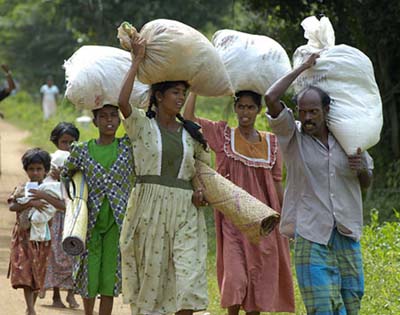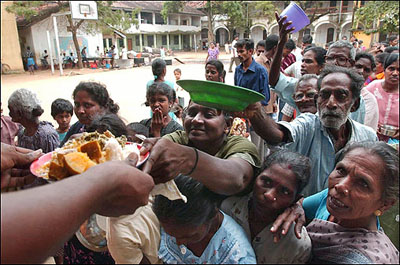Ilankai Tamil Sangam30th Year on the Web Association of Tamils of Sri Lanka in the USA |
|||
 Home Home Archives Archives |
Reflecting on Tamil Displacement over 30 YearsOn World Refugee Dayby LTTE Peace Secretariat, June 20, 2007
Press Release by the LTTE Spokesperson on Human Rights and Humanitarian Affairs UN High Commission for Refugees (UNHCR) for Sri Lanka reports that 300,000 people were displaced from April 2006 to April 2007 in the Tamil homeland. This, though tragic and coming during a ceasefire period, is just a small part of the repeated and large scale displacement to which Tamil people have been put through. The vast majority, more than 200,000, of these recently displaced, are from Batticaloa and Trincomalee. Many of the recently displaced live under tarpaulin tents under direct sunlight. They lack the very basic facilities to cook and bathe. They walk miles to collect drinking water. Children’s education is devastated. Health in these refugee camps can be severely compromised due to inadequate hygiene in a crowded situation. The 2004 Boxing Day tsunami created another 350,000 refugees in the Tamil homeland. Unlike the affected people among the Sinhala population who have been given permanent homes with the international aid, large percentage of the tsunami-affected Tamil people continue to live in temporary shelters intended to last only six months because the Sri Lankan government blocked tsunami aid reaching the Tamils. These shelters are also crowded denying privacy to families. They become flooded during rain. In effect, over a period of 30 years, almost the entire Tamil population from the Tamil homeland has been displaced at least once and a large percentage of them displaced multiple times. The 1983 pogrom against the Tamils displaced many Tamils from Colombo to other countries and also to the Tamil homeland. The confiscation of private land surrounding the Palaly airport since the 1980’s has displaced thousands of families. A similar confiscation of land in Kytes around the same period displaced more families. Palaly and Kytes now have extensive military bases using land owned by Tamil people after forcefully evicting the owners. A similar confiscation of land from Tamils took place along the eastern region of the Tamil homeland starting from Kokkilai in the north all the way down to Amparai. These confiscated lands have been converted into high security zones and some of it was settled by Sinhalese brought from other districts. The latest in this saga of confiscating land in the name of high security zones is the takeover of Sampur and Mutur-east in Trincomalee from which Tamil people were displaced in mid 2006 by military action. The creation of high security zones alone has created 300,000 long term refugees who were refugees before the latest ceasefire agreement was signed and have remained refugees to date.
People escaping indiscriminate military attacks also created an enormous number of refugees. The largest was created in 1995, about 400,000, during the capture of Jaffna. Although many returned to Jaffna, at least half of those who displaced from Jaffna at that time have gone overseas or are living in Vanni. At least 500,000 Tamils have left the country to escape the incessant threat to life and education. The latest 300,000 over the last one year must be added to this existing number of displaced. The total number of displaced, therefore, is in excess of one and a half million. The total Tamil population in the Tamil homeland is just over 2 million. Thus the displaced represents 75% of the entire population. Forcefully evicting people repeatedly and in such large numbers and confiscating their land is a clear violation of the human rights of the people and it also violates many of the international humanitarian norms. When measured in terms of the depth of displacement suffered rather than in terms of numbers Tamil people are the worst affected in the world at present. The world should wake up to this brutalization of a people by a State. |
||
|
|||


